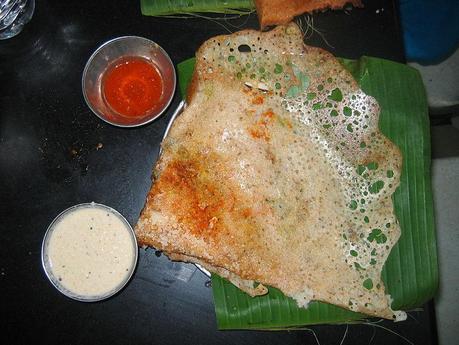I swear they are all related.
The first masala dosa I ever ate at a commercial establishment in Edmonton looked like it had been trampled by an elephant, smelt like tandoori chicken flavoured with civet poop and had an astonishing resemblance to the taste of the cardboard boxes that camera traps come in. After that, I decided to never to eat a dosa outside south India again, and even within south India, subject any dosa manufactured outside Tamil Nadu or Karnataka to rigorous scrutiny before eating. Well I recently broke my vow and it looks like Edmonton’s dosa making skills have picked up. But to hungry field ecologists, nothing can match the dosas made by a nameless anonymous shop in the small backwater town of Tenkasi, which is situated in the shadow of the Western Ghats in Tamil Nadu.
Gourmets will often tell you that the best dosas in India are made in Bangalore or Chennai, but gourmets are wrong. The best dosas are made in a tiny thattukada (roadside shop) in Tenkasi, on the dusty main road leading to Kuttalam. It is a nondescript shop – so nondescript that I never got its name. The only thing vaguely descript about it is that it is situated conveniently close to an ATM (State Bank ATMs are the center of life in many remote areas), and also close to an equally anonymous workshop who does poor quality jugaad repairs of broken-down field vehicles. But its pretty famous locally, and once in a while, some enthusiast from Chennai will spend a few hours in the sweltering 40 degree heat, trying to track down this place that he has heard of by word of mouth. Its pretty expensive by local standards: an ordinary dosa will set you back Rs 20 (~$0.3). But its real value for money; the podi dosa, coriander dosa, garlic dosa, spinach dosa, are the best I have ever had.
Another important pilgrimage center for the gourmet visitor to the Shencottah Gap is a busy hotel in Aryankavu on the Kerala side. Now I am a very tolerant person, but once in a while, I see someone and I have an instant, almost uncontrollable urge to punch them in the face. The owner of this shop is one such person. Perhaps it is because of the way he smashes down the plate of half-cooked rice in front of you, having just casually pulled out a cockroach from it. Or perhaps it has to do with the sambar he serves with a smirk, which seems to be 99% water, 0.9% blue-green algae, and 0.1% remnant vegetable matter (note: the vegetable matter includes masala powder, since masalas are derived from Kingdom Plantae). His vadas also seem to be fried in third-hand locomotive engine oil. Unfortunately, as any ecological modeller will tell you, your foraging options depend on what is available; and there is very little available in the village of Aryankavu. To make up though, his coffee is worse than the worst coffee in North America.
But places like these are a good test of people’s ability to do fieldwork. If you go to the nameless shop and look for bottled water, you probably wont make it very long; aint no bottled water in the field. If you go to the other place and make it through a meal without getting into a fight with the owner or throwing up, you are unusually patient and also have outstanding digestive processes; you may actually make it!

http://en.wikipedia.org/wiki/Dosa#mediaviewer/File:GntRavvaDosa.jpg
